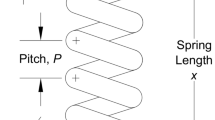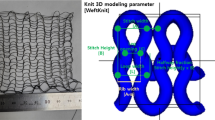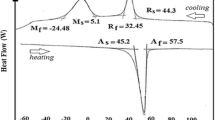Abstract
This study describes a new method for modeling the electric resistance of Shape Memory Alloy wires (SMA). In order to account for the shape memory effect, wire- and spring-based devices have recently been employed in the design of actuators for displacement control. Because of its nonlinear characteristics, understanding the change in resistance over temperature and time is important in control system design. As a result, additional experiments and modeling are needed to determine the major influence of temperature fluctuation from ambient to transformation temperature in the thermal cycle, which is currently unexplored in the literature. The primary goal of this study is to find the optimum SMA wire for the tactile device under development. In terms of length, diameter changes, and stress impact, a comprehensive parametric analysis of the selected sample was performed. Furthermore, the novel approaches for determining resistance value over temperature-dependent stress fluctuation improve the displacement control strategy. The outcomes of the confirmed experiments and simulations are shown to be superior to the present method.









Similar content being viewed by others
References
Dutta SM, Ghorbel FH (2005) Differential hysteresis modeling of a shape memory alloy wire actuator. IEEE/ASME Trans Mechatron 10(2):189–197
Zhu S, Zhang Y (2007) ‘A thermomechanical constitutive model for super elastic SMA wire with strain-rate dependence’ IOP publishing. J Smart Mater Struct 16(5):1696–1707
Novak V, Sittner P, Dayananda GN, Braz-Fernandes FM, Mahesh KK (2008) Electric resistance variation of NiTi shape memory alloy wires in thermomechanical tests: Experiments and simulation. Mater Sci Eng A 482:127–133
Hartl D, Lagoudas D (2008) Thermomechanical Characterization of Shape Memory Alloy Materials. Shape Memory Alloys. 48:53–118. https://doi.org/10.1007/978-0-387-47685-8_2
Roberto R, Tannuri EA (2009) Modeling, control and experimental validation of a novel actuator based on shape memory alloys. Mechatronics 19(7):1169–1177
Lan C-C, Fan C-H (2010) An accurate self-sensing method for the control of shape memory alloy actuated flexures. Sens Actuators A 163(1):323–332
Nespoli A, Besseghini S, Pittaccio S, Villa E, Viscuso S (2010) The high potential of shape memory alloys in developing miniature mechanical devices: a review on shape memory alloy mini-actuators. J Sens Actuators A 158(1):149–160
Cui Di, Song G, Li H (2010) ‘Modeling of the electrical resistance of shape memory alloy wires’ IOP Publishing. Smart Mater Struct 19(N0):5
Pathak A, Brei D, Luntz J (2010) Transformation strain-based method for characterization of convective heat transfer from shape memory alloy wires. Smart Mater Struct 19(3):1–10
Donmez B, Ozkhan B, Kadioglu S (2010) Precise position control using shape memory alloy wires. Turk J Electr Eng Comput Sci 18(5):899–912
Song H, E. Kubica, R. Gorbet (2011) Resistance modelling of SMA wire actuators. In: Proceedings of international workshop smart materials, Structures and NDT in Aerospace Conference
Zhang Jian Jun (2011) Modeling of electrical resistivity evolution using free energy analysis for NiTi shape memory alloy wires. Adv Mater Res 311:2282–2285
Furst SJ, Seelecke S (2012) Modeling and experimental characterization of the stress, strain, and resistance of shape memory alloy actuator wires with controlled power input. J Intell Mater Syst Struct 23(11):1233–1247
Ma J, Huang H, Huang J (2013) Characteristics Analysis and Testing of SMA Spring Actuator. Adv Mater Sci Eng 2013:1–7
Bhargaw HN, Ahmed M, Sinha P (2013) Thermo-electric behavior of NiTi shape memory alloy. Trans Nonferrous Metals Soc China 23(8):2329–2335
Georges T, Brailovski V, Terriault P (2013) Experimental bench for shape memory alloys actuators design and testing. Soc Exp Mech Wily Online Library Exp Tech 37(6):24–33
Roh J-H (2014) Thermomechanical modeling of shape memory alloys with rate dependency on the pseudoelastic behavior. Math Probl Eng 2014:1–9
Eisakhani A, Gao X, Gorbet R, Culham JR (2014) Electrical resistance and natural convection heat transfer modeling of shape memory alloy wires. In: ASME International Mechanical Engineering Congress and Exposition. American Society of Mechanical Engineers, vol 46569, p V08BT10A014
Talebi H, Golestanian H, Zakerzadeh MR, Homaei H (2014) Thermoelectric Heat Transfer Modeling of Shape Memory Alloy Actuators. In: the proceedings of 22nd Annual International Conference on Mechanical Engineering-ISME2014, 2014
Chemisky Y, Hartl DJ, Meraghni F (2018) Three-dimensional constitutive model for structural and functional fatigue of shape memory alloy actuators. Int J Fatigue 112:263–278
Viet NV, Zaki W, Moumni WZ (2019) A model for shape memory alloy beams accounting for tensile compressive asymmetry. J Intell Mater Syst Struct 30(2697–2715):2019
Chatziathanasiou D, Chemisky Y, Chatzigeorgiou G, Meraghni F (2016) Modeling of coupled phase transformation and reorientation in shape memory alloys under non-proportional thermomechanical loading. Int J Plast 82:192–224
Technical datasheets of Dynalloy. INC, Technical characteristics of flexinol wire, F1140RevJ, Available online: https://www.dynalloy.com/pdfs/TCF1140.pdf.
Lara-Quintanilla A, Bersee HEN (2016) A study on the contraction and cooling times of actively cooled shape memory alloy wires. J Intell Mater Syst Struct 27(3):403–417
Lima WM, de Araújo CJ, Gomes RM, da Rocha Souto C, Marques de Lima AM, Cavalcanti Catunda SY (2017) Study of the stability of the NiTi wire applied to thermomechanical actuators. In: 2017 IEEE International Instrumentation and Measurement Technology Conference (I2MTC), pp 1–6
Driesen JB, Fischer C, de Sousa GL, et al. (2018) A labview/arduino measurement system for shape memory alloy wires. In: 2018 13th IEEE International Conference on Industry Applications (INDUSCON), pp 1179–1186
Sreekanth M (2018) Abraham T Mathew, R Vijayakumar, ‘A novel model-based approach for resistance estimation using rise time and sensorless position control of sub-millimeter shape memory alloy helical spring actuator.’ J Intell Mater Syst Struct 29(6):1050–1064
Dorin C, Blanco D, Moreno LE (2019) Flexible shape-memory alloy-based actuator: Mechanical design optimization according to application. Actuators Multidiscip Digital Publ Inst 9(2):87–94
Sakagami T, Seki K, Iwasaki M (2019) Sensorless position control based on resistance and heat transfer models in shape memory alloy actuators. In: 2019 IEEE/ASME International Conference on Advanced Intelligent Mechatronics (AIM), pp 217–222
Je-Sung K (2018) Design of shape memory alloy coil spring actuator for improving performance in cyclic actuation. Materials 11(11):1–16
Zhang D, Zhao X, Han J, Li X, Zhang B (2019) Active modeling and control for shape memory alloy actuators. IEEE Access 7:162549–162558
El-Naggar A, Youssef MA (2020) Shape memory alloy heat activation: State of the art review. AIMS Mater Sci 7(6):836–858
Toptas E, Celebi MF, Ersoy S (2021) Measurement of temperature and displacement with NiTi actuators under certain electrical conditions. J Measurements Eng 9(2):15
Liu X, Liu H, Tan J (2021) Actuation frequency modeling and prediction for shape memory alloy actuators. IEEE/ASME Trans Mechatron 26(3):1536–1546
Author information
Authors and Affiliations
Corresponding author
Additional information
Publisher's Note
Springer Nature remains neutral with regard to jurisdictional claims in published maps and institutional affiliations.
Rights and permissions
About this article
Cite this article
Vaijapurkar, V.B., Ravinder, Y. Electrical Resistance Modeling of Shape Memory Alloy Wire Using an Efficient Performance Analysis Approach. Shap. Mem. Superelasticity 8, 168–182 (2022). https://doi.org/10.1007/s40830-022-00369-y
Received:
Revised:
Accepted:
Published:
Issue Date:
DOI: https://doi.org/10.1007/s40830-022-00369-y




